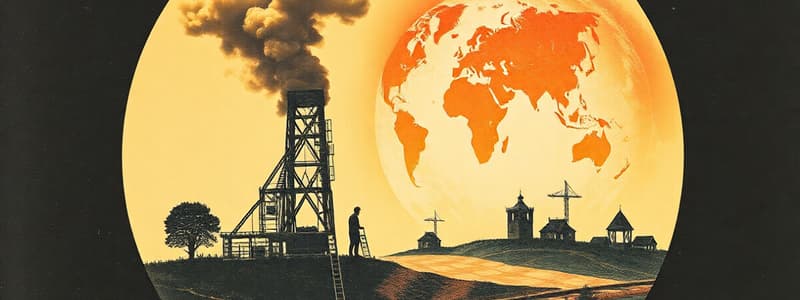Podcast
Questions and Answers
Which gas makes up the largest percentage of clean, dry air at the Earth's surface?
Which gas makes up the largest percentage of clean, dry air at the Earth's surface?
- Carbon dioxide
- Nitrogen (correct)
- Oxygen
- Argon
The El Niño Southern Oscillation (ENSO) is best described as which type of phenomenon?
The El Niño Southern Oscillation (ENSO) is best described as which type of phenomenon?
- A localized weather pattern affecting only coastal regions
- A predictable seasonal change with minimal ecological impact
- A large-scale atmospheric and oceanic phenomenon (correct)
- A small-scale geological event causing minor shifts in ocean currents
What is the primary effect of increased fixed nitrogen cycling due to human activity?
What is the primary effect of increased fixed nitrogen cycling due to human activity?
- It enhances biodiversity by providing essential nutrients to all ecosystems.
- It restores natural habitats that have been damaged by pollution.
- It stabilizes the atmospheric composition, reducing greenhouse gas effects.
- It can lead to altered nutrient balances and pollution in various ecosystems. (correct)
How do rapid changes in global land use patterns primarily threaten biological diversity?
How do rapid changes in global land use patterns primarily threaten biological diversity?
What is one of the main ways human activity is altering the composition of the atmosphere?
What is one of the main ways human activity is altering the composition of the atmosphere?
How does the El Niño Southern Oscillation (ENSO) primarily impact global ecological systems?
How does the El Niño Southern Oscillation (ENSO) primarily impact global ecological systems?
Which of the following is a significant consequence of the increased amount of fixed nitrogen cycling through the biosphere due to human activities?
Which of the following is a significant consequence of the increased amount of fixed nitrogen cycling through the biosphere due to human activities?
What is the primary way in which altered land use patterns contributes to habitat fragmentation?
What is the primary way in which altered land use patterns contributes to habitat fragmentation?
Which of the following human activities contributes most significantly to rising concentrations of carbon dioxide in the atmosphere?
Which of the following human activities contributes most significantly to rising concentrations of carbon dioxide in the atmosphere?
If the percentage of argon in the atmosphere increased from 0.93% to 1.93%, and the percentages of nitrogen and oxygen remained constant, what would be the new percentage of carbon dioxide?
If the percentage of argon in the atmosphere increased from 0.93% to 1.93%, and the percentages of nitrogen and oxygen remained constant, what would be the new percentage of carbon dioxide?
If a new industrial process significantly reduced global nitrogen levels, what would be the most likely initial impact on terrestrial ecosystems?
If a new industrial process significantly reduced global nitrogen levels, what would be the most likely initial impact on terrestrial ecosystems?
Which scenario would most likely exacerbate the negative impacts of El Niño events on coastal fisheries?
Which scenario would most likely exacerbate the negative impacts of El Niño events on coastal fisheries?
A large area of rainforest is cleared and converted into pasture for cattle ranching. What is the most likely long-term effect on regional biodiversity and carbon cycling?
A large area of rainforest is cleared and converted into pasture for cattle ranching. What is the most likely long-term effect on regional biodiversity and carbon cycling?
Imagine a program that aims to restore a deforested area by planting trees. Which of these strategies would best promote long-term carbon sequestration and biodiversity?
Imagine a program that aims to restore a deforested area by planting trees. Which of these strategies would best promote long-term carbon sequestration and biodiversity?
If the concentration of carbon dioxide in the atmosphere were to double, what would be the most likely initial effect on global ecosystems?
If the concentration of carbon dioxide in the atmosphere were to double, what would be the most likely initial effect on global ecosystems?
What is a primary consequence of human-induced increases in fixed nitrogen within ecosystems?
What is a primary consequence of human-induced increases in fixed nitrogen within ecosystems?
How does changing land use, such as deforestation for agriculture, affect regional climate patterns?
How does changing land use, such as deforestation for agriculture, affect regional climate patterns?
What is the likely outcome of a sustained increase in atmospheric argon concentration on global climate patterns and ecological systems?
What is the likely outcome of a sustained increase in atmospheric argon concentration on global climate patterns and ecological systems?
Which of the following correctly describes the relationship between the El Niño Southern Oscillation (ENSO) and the distribution of marine life?
Which of the following correctly describes the relationship between the El Niño Southern Oscillation (ENSO) and the distribution of marine life?
A large-scale reforestation effort is undertaken to combat rising atmospheric carbon dioxide levels. What additional ecological benefit would likely result from this initiative?
A large-scale reforestation effort is undertaken to combat rising atmospheric carbon dioxide levels. What additional ecological benefit would likely result from this initiative?
How would a significant increase in atmospheric argon concentration, without changes in nitrogen or oxygen, most likely affect the percentage of other trace gases?
How would a significant increase in atmospheric argon concentration, without changes in nitrogen or oxygen, most likely affect the percentage of other trace gases?
Which of the following scenarios would most likely lead to a positive feedback loop that accelerates the effects of the El Niño Southern Oscillation (ENSO) on global temperatures?
Which of the following scenarios would most likely lead to a positive feedback loop that accelerates the effects of the El Niño Southern Oscillation (ENSO) on global temperatures?
If human activities continue to increase fixed nitrogen inputs into ecosystems, which of the following long-term effects is most likely to occur?
If human activities continue to increase fixed nitrogen inputs into ecosystems, which of the following long-term effects is most likely to occur?
How does the conversion of large areas of natural forests into agricultural land primarily impact regional climate patterns?
How does the conversion of large areas of natural forests into agricultural land primarily impact regional climate patterns?
Which of the following strategies would be the most effective in mitigating the impacts of human activities on the global nitrogen cycle?
Which of the following strategies would be the most effective in mitigating the impacts of human activities on the global nitrogen cycle?
What is the most direct consequence of increased fixed nitrogen cycling in coastal marine ecosystems?
What is the most direct consequence of increased fixed nitrogen cycling in coastal marine ecosystems?
How could altered land use patterns, such as deforestation in the Amazon, most significantly affect regional precipitation?
How could altered land use patterns, such as deforestation in the Amazon, most significantly affect regional precipitation?
If the concentration of atmospheric carbon dioxide continues to rise, what is the most likely long-term impact on ocean pH?
If the concentration of atmospheric carbon dioxide continues to rise, what is the most likely long-term impact on ocean pH?
What is the most likely consequence if the intensity and frequency of El Niño events increase due to climate change?
What is the most likely consequence if the intensity and frequency of El Niño events increase due to climate change?
What is the primary reason that changes in atmospheric composition, specifically increased carbon dioxide, have a disproportionately large impact on global temperatures?
What is the primary reason that changes in atmospheric composition, specifically increased carbon dioxide, have a disproportionately large impact on global temperatures?
How might increased frequency of El Niño events driven by climate change affect migratory bird populations that rely on specific coastal stopover habitats?
How might increased frequency of El Niño events driven by climate change affect migratory bird populations that rely on specific coastal stopover habitats?
What is the most likely consequence of a large-scale expansion of agriculture into previously uncultivated grasslands on the cycling of nitrogen?
What is the most likely consequence of a large-scale expansion of agriculture into previously uncultivated grasslands on the cycling of nitrogen?
How does the fragmentation of forests into smaller, isolated patches most significantly impact local biodiversity?
How does the fragmentation of forests into smaller, isolated patches most significantly impact local biodiversity?
What is the most significant way that increased concentrations of atmospheric carbon dioxide are affecting ocean ecosystems?
What is the most significant way that increased concentrations of atmospheric carbon dioxide are affecting ocean ecosystems?
If atmospheric argon concentrations doubled while nitrogen and oxygen concentrations remained constant, what immediate effect would this have on surface air temperature, assuming no other changes?
If atmospheric argon concentrations doubled while nitrogen and oxygen concentrations remained constant, what immediate effect would this have on surface air temperature, assuming no other changes?
Flashcards
El Niño Southern Oscillation (ENSO)
El Niño Southern Oscillation (ENSO)
Large-scale climate pattern involving changes in sea surface temperatures in the central and eastern tropical Pacific Ocean.
Increased Fixed Nitrogen
Increased Fixed Nitrogen
Human activities have significantly increased the amount of nitrogen available in ecosystems.
Land Use Changes
Land Use Changes
Changes in how land is used (e.g., deforestation, urbanization) impacting habitats and species.
Changing Atmospheric Composition
Changing Atmospheric Composition
Signup and view all the flashcards
Atmospheric Nitrogen Percentage
Atmospheric Nitrogen Percentage
Signup and view all the flashcards
Human-Driven Nitrogen Increase
Human-Driven Nitrogen Increase
Signup and view all the flashcards
Land Use Change Impacts
Land Use Change Impacts
Signup and view all the flashcards
Atmospheric Composition Change
Atmospheric Composition Change
Signup and view all the flashcards
Atmospheric Nitrogen Content
Atmospheric Nitrogen Content
Signup and view all the flashcards
ENSO
ENSO
Signup and view all the flashcards
Anthropogenic Nitrogen Fixation
Anthropogenic Nitrogen Fixation
Signup and view all the flashcards
Global Land Use Change
Global Land Use Change
Signup and view all the flashcards
Global Atmospheric Change
Global Atmospheric Change
Signup and view all the flashcards
Atmospheric Nitrogen (N2)
Atmospheric Nitrogen (N2)
Signup and view all the flashcards
ENSO Definition
ENSO Definition
Signup and view all the flashcards
Human Impact on Nitrogen
Human Impact on Nitrogen
Signup and view all the flashcards
Atmospheric Change
Atmospheric Change
Signup and view all the flashcards
El Niño Southern Oscillation
El Niño Southern Oscillation
Signup and view all the flashcards
Increased Nitrogen Cycling
Increased Nitrogen Cycling
Signup and view all the flashcards
Changing Atmosphere
Changing Atmosphere
Signup and view all the flashcards
Atmospheric Air Composition
Atmospheric Air Composition
Signup and view all the flashcards
Study Notes
- Ecology addresses concepts and applications at a global scale.
- The El Niño Southern Oscillation influences ecological systems on a global scale.
- Human activity has greatly increased the quantity of fixed nitrogen cycling through the biosphere.
- Rapid changes in global patterns of land use threaten biological diversity.
- Human activity is changing the composition of the atmosphere.
Atmospheric Composition
- Clean, dry air at the Earth's surface is composed of approximately 78.08% nitrogen.
- Clean, dry air at the Earth's surface is composed of approximately 20.94% oxygen.
- Clean, dry air at the Earth's surface is composed of approximately 0.93% argon.
- Clean, dry air at the Earth's surface is composed of approximately 0.03% carbon dioxide.
- Clean, dry air at the Earth's surface is composed of approximately <0.00005% ozone.
- Clean, dry air at the Earth's surface also contains water vapor and traces of helium, hydrogen, krypton, methane, and neon.
- Most atmospheric gases are concentrated in the troposphere, which extends 9 to 16 km from the Earth’s surface
- The stratosphere extends from the troposphere to an altitude of 50 km
- Ozone shields Earth from UV light and concentrates in the stratosphere.
- The mesosphere and the thermosphere exist above the troposphere.
- The Earth's surface remains warm because the atmosphere traps heat.
- Greenhouse gases, such as water vapor, carbon dioxide, methane, ozone, nitrous oxide, and CFCs, cause heat to be trapped.
- Gases absorb infrared radiation and reemit most of it back to earth.
- About 30% of incoming solar energy is generally reflected by clouds and particulate matter.
- Approximately 70% of incoming solar energy is absorbed by the atmosphere and the surface.
Ecosystem Response to Climate Change
- Studying patterns across many taxa and over long time periods is important for studying changes.
- Menzel et al. used 100,000 time series records to study plant phenological shifts.
- Parmesan and Yohe (2003) analyzed hundreds of studies.
- Parmesan and Yohe (2003) found highly significant, nonrandom patterns of change in accordance with climate records across the published record of more than 1,700 taxonomic groups.
El Niño Southern Oscillation (ENSO)
- The El Niño Southern Oscillation, a large-scale atmospheric and oceanic phenomenon, influences ecological systems on a global scale.
- A warm current appears off the coast of Peru during El Niño Southern Oscillation.
- El Niño generally occurs around Christmas season, hence the name referencing the Christ child.
- The Southern Oscillation refers to oscillation in atmospheric pressure that extends across the Pacific Ocean.
- Walker (1924) discovered the correspondence between barometric pressure across the Pacific and rainfall during monsoons.
- Barometric pressure rises in the western Pacific, causing decrease in pressure in the eastern Pacific, and vice versa, which results in the Southern Oscillation.
- Droughts in Australia, India, Indonesia, and parts of Africa associate with the Southern Oscillation.
- Winter temperatures in Canada also associate with the Southern Oscillation.
- Bjerknes established links between El Niño water temperatures and the Southern Oscillation.
- A gradient in sea surface temperatures over the central Pacific produces large-scale atmospheric circulation.
- Air masses flow westward and gather moisture as it warms.
- Westward-flowing air joins rising air in the western Pacific.
- ENSO is a dynamic, large-scale system which drives climatic variability globally.
- During mature phase of ENSO, the eastern tropical Pacific sea surface is much warmer than average, and barometric pressure over the eastern Pacific is lower than average.
- Storm formation occurs over the eastern Pacific, along with increased precipitation to North and South America.
- Walker Circulation is the air circulation in the plane of the equator.
- During La Niña, the location of storm generation in the Pacific moves westward.
- During El Niño, the location of major storm generation moves eastward.
El Niño and La Niña
- Sea Surface Temperatures are cooler than average in the western Pacific during El Niño events.
- Barometric pressure is higher than average and results in drought over the western Pacific during El Niño events.
- La Niña - periods of lower sea surface temperatures exhibit a higher-than-average pressure in the eastern tropical Pacific.
- Drought impacts much of North America during La Niña events.
- Higher than average precipitation in the western Pacific is also associated with La Niña events.
- Coastal waters along most of the west coast of South America are relatively cool under average conditions.
- A tongue of cool water extends westward in the Pacific, which occurs due to surface upwelling.
- Warm surface water shuts off upwelling, decreasing nutrient supply and phytoplankton production during mature phases of El Niño.
- Food for consumers in the coastal food web is reduced, which causes fish population to decline.
- Strong El Niños bring exceptionally wet or exceptionally dry conditions to a large part of the planet based on geographic location.
Impact on Terrestrial Ecosystems
- The strong El Niño of 1982 to 83 was the source of many storms deep into the interior of North America, leading to high precipitation in the Great Salt Lake basin.
- Between 1983 and 1987, the Great Salt Lake rose 3.7 m.
- The Great Salt Lake Salinity dropped by 50 g/L, resulting in the lake being invaded by predaceous insect Trichocorixa verticalis.
- A trophic cascade was induced, and phytoplankton biomass increased in the Great Salt Lake .
- The Great Salt Lake level fell by 1990, and changes reversed.
- Drought is brought to Australia by El Niño, and abundant rainfall is brought by La Niña.
- Episodic Establishment by Perennial Plants occur in the soil due to these weather pattern changes.
- New small-leaf hopbush associates with La Niña.
- Plant community structure in Australia is influenced by ENSO.
- Red kangaroos (Macropus rufus) occupy most of Australia's semiarid interior.
- Females simultaneously have young at different stages (a joey following her, one nursing, and an embryo waiting to enter the pouch) in wet years, indicated by a plentiful food supply.
- Most young die soon after leaving the pouch under marginal conditions.
- Females will stop lactating if food becomes scarcer, and young die in the embryo stage.
- Red kangaroos stop breeding during severe, prolonged droughts.
- These animals breed quickly, and young enter the pouch within 60 days of the onset of significant rainfall.
- By reproducing large numbers of offspring under favorable conditions, kangaroos increase the number of adults that will face El Niño-induced droughts.
- Cairns and Grigg (1993) discovered a tight coupling of M. rufus populations to El Niño.
Humans and the Nitrogen Cycle
- Intensive agriculture and industrial processes used by humans causes us to begin manipulating nitrogen cycle on a massive scale.
- N-fixing bacteria/plants contributes 100 Tg/yr of fixed nitrogen.
- Marine environments contribute 5 to 20 Tg/yr of fixed nitrogen.
- Lightning contributes 10 Tg/yr of fixed nitrogen.
- The total natural sources contribute 130 Tg/yr of fixed nitrogen.
- Human sources of N-fixation account for 135 to 145 Tg/yr.
- Nitrogen fixation by human processes now exceeds nonhuman sources.
Tropical Deforestation
- At least half of Earth's species are supported by tropical forests.
- Tropical forests occur in 73 countries and once covered 11,610,360 km², as reported Skole and Tucker (1993).
- Brazil contains one-third of the total tropical forests and has the highest deforestation rate.
- By 1988, 230,000 km² had been deforested at an annual rate of 15,000 km².
- Deforestation peaked in 2004 at 27,000 km².
- Loss of forest area and edge effects influence forest ecology.
- Edge effects can influence forest ecology.
- Isolated forest fragments are exposed to greater amounts of solar radiation and wind.
- Physical environment within fragments and along forest edges changes.
- Temperatures become hotter, drier and solar intensity becomes higher in forest fragments.
- Diversity of many animal groups decreases due to deforestation.
Deforestation on a Global Scale
- 76,000 km² of tropical forest was lost globally each year in the 2000s.
- Deforestation has also occurred in temperate and boreal regions.
- Human activity has transformed roughly half the ice-free land cover of Earth.
- Terrestrial biomes are highly fragmented and some are nearly eliminated
- Global climate change potential is increased with deforestation.
Human Impact on Atmosphere
- Record Of Atmospheric Composition During Last 160,000 Years Was Extracted From Ice Cores In Greenland and Iceland.
- Samples of atmosphere Trapped In Ice during glacial periods.
- Antarctic Ice Cores provide atmospheric CO₂ record for last 800,000 years.
- CO₂ oscillation ranges between 170 and 300 ppm.
- Low CO₂ levels correspond to low temperatures as show via examining ice strata dating.
- Higher CO₂ levels correspond to interglacial periods, based on ice studies.
- Concentration of atmospheric CO₂ increased dramatically in the 1800s and 1900s
- Emission from fossil fuel burning releases 5,600 Tg/yr of C.
- The annual increase in atmospheric carbon is 3,500 Tg/yr.
- Interruptions in the pattern of atmospheric CO₂ increases correspond to: World War I, The Great Depression, and World War II.
- The British Antarctic Survey discovered major reduction in atmospheric ozone During 1985.
- Stopping Chlorofluorocarbons Is The Focus following the ozone discovery.
- The Montreal Protocol occurred in 1987.
- The ozone hole reached its maximum area in 2000.
- The Ozone Layer regeneration Starts In 2003.
Studying That Suits You
Use AI to generate personalized quizzes and flashcards to suit your learning preferences.
Related Documents
Description
Earth's atmosphere is composed mainly of nitrogen, oxygen, and argon, with trace gases. Ozone in the stratosphere is critical for UV protection. The greenhouse effect, caused by gases like carbon dioxide and methane, maintains Earth's temperature by trapping heat.




